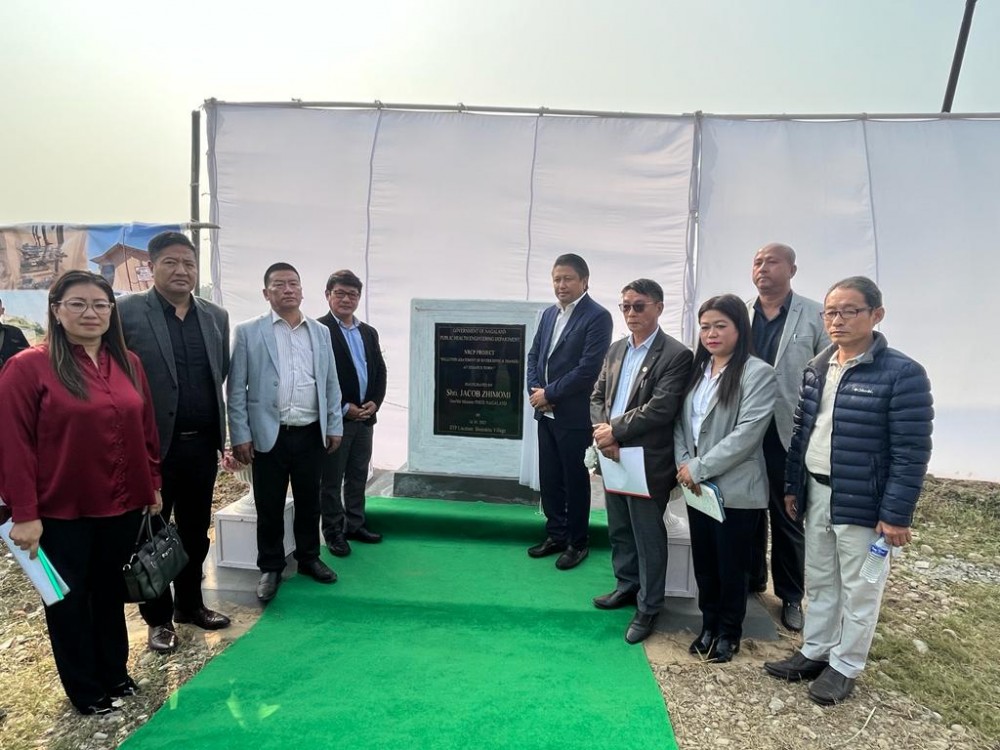Jacob Zhimomi, Minister for PHED along with department and guest officials during the unveiling of the Sewage Treatment Plant at Shozukhu village, Dimapur on January 14. (Morung Photo)

PHED Minister inaugurates sewage treatment plant at Shozukhu village, Dimapur
Morung Express News
Dimapur | January 14
In a first of its kind for Nagaland and Dimapur in particular where two major rivers, Dhansiri and Diphu run through the district, a Sewage Treatment Plant (STP) for “Interception, Diversion and Treatment of waste water,” was unveiled at Shozukhu village by the Public Housing and Engineering Department (PHED) Minister, Jacob Zhimomi on January 14.
Located within an area of 13.6 hectares, the STP was built under the National River Conservation Plan project which was sanctioned and approved in the year 2005 by the Ministry of Environment, Forest and Climate Change (MoEFCC) at a total cost of Rs 78.65 crore.
In his inaugural speech, the PHED Minister stated that this was a long overdue project. “It was a very challenging task and I am sure the department engineers had given considerable effort to see that the project was completed,” he remarked.
The project was initially under the MoEFCC but later handed over to the Department of Water Resources, Rivers Development and Ganga Rejuvenation, Ministry of Jal Shakti. “We could have commissioned it two years back but due to the pandemic it could not be completed,” he said.
Zhimomi also noted that the primary objective was to conserve the quality of the two rivers, Dhansiri and Diphu which were highly polluted. “A lot of waste was discharged into these two rivers and so this was a way to intercept the sewage discharge, by way of having a stabilizing pond,” he added.
In addition, the National Green Tribunal had also earlier warned states for not setting up of waste management facilities. “So for Nagaland, this project has saved the skin of the government,” he remarked, further announcing that it will send a positive message to all the other states on how to segregate and manage waste water particularly in the cities.
Moreover as Nagaland was declared Open Defecation Free (ODF) in 2018, the state was also entering into a new phase dubbed as ‘ODF+.’ “So that includes sanitation, waste management, grey water management where we will rejuvenate and reuse this water for different purposes,” he said.
Brief background of the project
Thsathrichem Sangtam, Chief Engineer, Sanitation & WSSO PHED, Nagaland in his technical report highlighted that the initial stages of survey was accomplished between 1999 and 2000. “The project was approved in 2005 and later work stated in 2006,” he said.
The project consists of the Sewage Treatment Plant including five Waste Stabilisation Ponds (WSPs), laboratory and equipments, administrative buildings and staff quarters, low cost sanitation, afforestation and public awareness programme.
At the beginning it was proposed for household connection and cleaning the nullahs and streams within Dimapur. But due to limitations, consumer connection could not be included. The project was approved for a budget of Rs 78.65 crores in 2014 with a 70:30 Central and State sharing of the expenditure. Sangtam further revealed that it was scheduled to be completed on March 31, 2022 but due to certain unavoidable circumstances the date was pushed to the following year.
Interception & diversion from identified nullahs to the STP
The main task of the project was for interception, diversion and treatment of waste water from three identified drains namely, the Lengri Nullah, Hospital Nullah and Sugarmill Nullah. From the interception points, the sewage water was then diverted to wet wells located at different sewage pumping stations. Later, they are collected into common collection chambers from where it flows down to the STP through the help of a gravity sewer line built across a length of 6 KMs.
Finally, the sewage water after arriving at the STP was treated into five WSPs, Anaerobic Pond (depth 4.5 meters), two Facultative Ponds (2.5 meters) and two Maturation Ponds. Sangtam mentioned that the STP has a capacity of 25.43 MLD (millilitres per day).
The treated waste water were proposed to be made available for irrigating agricultural fields within the vicinity of the STP, sprinkling road construction sites to control dust pollution, clearing of sewage drains and for use by fire stations. This was in accordance to the National Green Tribunal (NGT) directives.
Completed project to be handed over to DMC
As per the Detailed Project Report (DPR), on completion of the project the PHED was expected to officially hand it over to the Dimapur Municipal Council (DMC) for its operation and maintenance works, Sangtam said. “After we have a thorough discussion and see their capability to manage this project.” However during the initial phase of its function, the PHED will operate and maintain it.
The department has estimated that the total minimum annual operational cost amounted to Rs 24.5 lakh approximately including working personnel.
Earlier, welcome address was given by Er Repangyangba Longkumer, Chief Engineer & HoD PHED, Nagaland who remarked that this was an opportunity to showcase a project which was one of its kind in Nagaland aimed at tackling river pollution. Hence, he encouraged the people to practice good habits to help improve and clean the environment.
Short speeches were delivered by S Ghozheto Aye, Head GB of Shozukhu Village and original land owner of the site where the project was set up, Mhalo Humtsoe, ADC, Dimapur and Mhathung Tungoe, Secretary, PHED, Nagaland.





